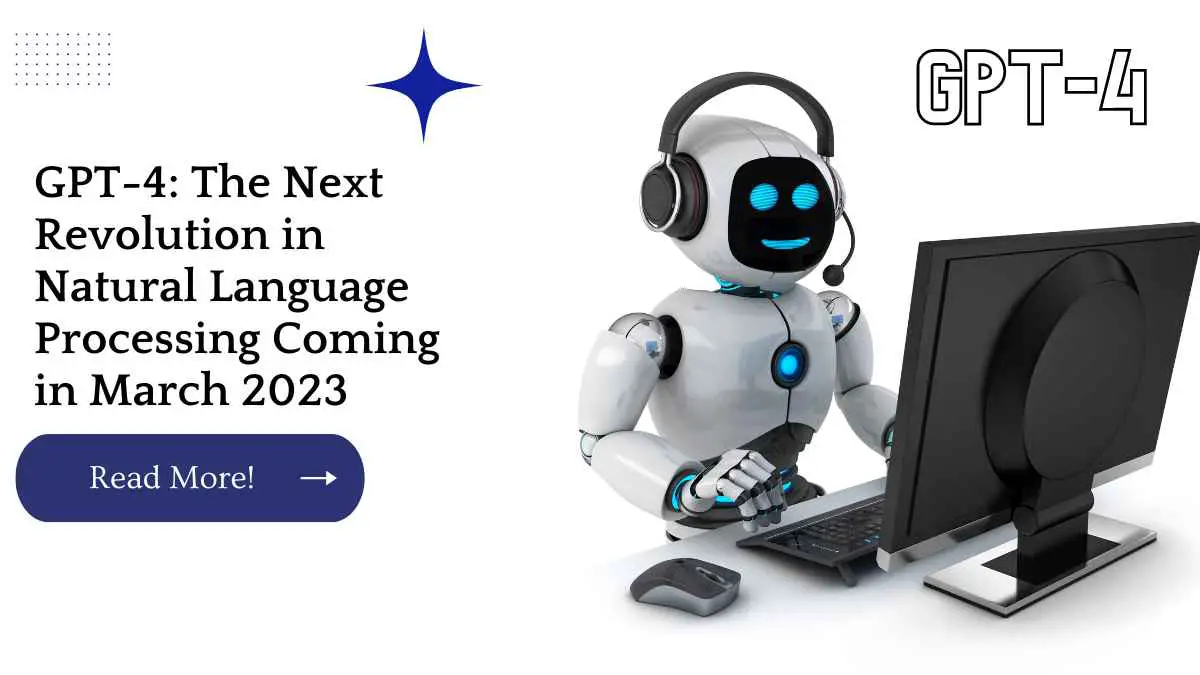The field of natural language processing (NLP) has made tremendous strides in recent years, thanks to the development of advanced language models such as GPT-3.
However, Microsoft-OpenAI’s upcoming release of GPT-4 promises to take NLP to new heights. In this article, we’ll explore what makes GPT-4 different from its predecessors, what it’s capable of, and what potential impact it could have on society.
| Takeaways |
|---|
| GPT-4 is a powerful natural language processing model developed by OpenAI. |
| It has the potential to revolutionize a wide range of fields, including education, healthcare, e-commerce, and media and entertainment. |
| GPT-4 is designed to be more powerful and capable than its predecessor, GPT-3. |
| Its release in March 2023 has generated a great deal of interest and speculation about its potential impact. |
| Ongoing research and exploration of GPT-4’s capabilities is expected to yield even more exciting applications and innovations in the future. |
Multimodal Processing: Understanding Text, Images, Video, and Sound
GPT-4’s biggest breakthrough is its ability to integrate different modalities of data. This means it can understand and process not only text-based data, but also images, videos, and sound. This multimodal approach allows for a more comprehensive understanding of language and context, which leads to more accurate and nuanced responses.
Previous language models, including GPT-3, relied primarily on text-based data to generate responses. While they were able to produce impressive results, they were limited in their ability to understand the broader context of language.
For example, if a model were asked the question “What color is the sky?” it might respond with “blue.” However, if the model were presented with an image of a cloudy sky, it might not be able to accurately answer the same question. GPT-4’s multimodal approach enables it to process visual and auditory information along with text, which allows it to generate more accurate and nuanced responses.
GPT-4 has the potential to change the game in natural language processing, and our deep dive into its unmatched performance reveals why. Learn more about the power of GPT-4 in our article on unveiling the power of GPT-4.
Multilingual Communication
Another key feature of GPT-4 is its ability to work across multiple languages. This will be a significant breakthrough for international communication, as it will allow GPT-4 to receive questions in one language and answer them in another. Furthermore, GPT-4’s accurate translation capability will make it easier for people to understand each other in different languages.
One of the challenges of cross-lingual communication is the differences in syntax, grammar, and vocabulary between languages.
Previous language models have struggled to accurately translate languages due to these differences. However, GPT-4’s multimodal approach enables it to understand the context of a given language, which allows it to generate more accurate translations.
The next leap in AI language generation has arrived with the introduction of GPT-4. Find out how this breakthrough technology is changing the way we think about language processing in our article on GPT-4: the next leap in AI language generation.
Processing Visual Data
GPT-4’s ability to process visual data is another major breakthrough. It can recognize objects, people, and scenes within images and videos. This makes it useful for industries such as media and advertising, where it can generate captions and automatically label large datasets.
Previous language models have struggled to process visual data, as they were primarily designed to understand text-based information. However, GPT-4’s multimodal approach enables it to understand the context of visual data, which allows it to generate accurate descriptions and labels.
This is particularly useful for industries such as media and advertising, where large amounts of visual data are generated and need to be processed.
Microsoft’s special event unveiled how GPT-4 is reinventing productivity with AI. Discover the ways in which GPT-4 is transforming the workplace and boosting productivity in our article on reinventing productivity with AI: unveiling GPT-4 at Microsoft’s special event.
OCR and Speech Recognition
Optical text recognition (OCR) and speech recognition are two other areas where GPT-4 is expected to excel. OCR is the process of converting text from images into editable text. This is useful for digitizing documents and making them searchable.
GPT-4’s ability to process visual data and understand context will make OCR more accurate than ever before. GPT-4 can also recognize speech and generate text-based transcripts of spoken words, making it useful for transcribing interviews, speeches, and meetings.
OCR and speech recognition are two areas where previous language models have struggled to produce accurate results. OCR is particularly challenging, as it requires the model to recognize text within an image and accurately transcribe it.
GPT-4’s multimodal approach enables it to understand the context of an image, which allows it to generate more accurate OCR results. Similarly, GPT-4’s ability to process sound along with text and images allows it to generate more accurate speech transcripts.
GPT-4’s multimodal AI capabilities are enhancing data analysis and decision-making in environmental sustainability. Find out how GPT-4 is contributing to a more sustainable future in our article on GPT-4 and environmental sustainability: enhancing data analysis and decision-making with multimodal AI.
Potential Impact on Society
The potential impact of GPT-4 on society is vast. Its ability to work across multiple languages and modalities will make communication easier and more accurate. This will be particularly beneficial for international business, education, and diplomacy. Additionally, its ability to process visual data and recognize speech will be useful for industries such as media, advertising, and publishing.
However, the impact of GPT-4 on the job market is uncertain. As language models become more advanced and capable of performing complex tasks, there is a risk that they could replace human workers in certain industries. This could lead to job losses and economic disruption.
Furthermore, the ethical implications of advanced language models such as GPT-4 are still being debated. There are concerns around the potential misuse of language models for propaganda, disinformation, and other nefarious purposes. As such, it’s important that these models are developed and used responsibly, with careful consideration given to their potential impact on society.
GPT-4 is set to enhance learning with its multilingual and multimodal models. Learn more about the impact of GPT-4 on education and language learning in our article on GPT-4 in education: enhancing learning with multilingual and multimodal models.
Conclusion
GPT-4 represents a major breakthrough in the field of natural language processing. Its ability to integrate different modalities of data, work across multiple languages, and process visual data and speech will enable it to perform a wide range of tasks that were previously impossible.
While its potential impact on society is vast, it’s important that we carefully consider its potential ethical implications and ensure that it is developed and used responsibly. The release of GPT-4 in March 2023 is something to look forward to, as it promises to revolutionize the field of NLP and change the way we communicate with each other.
Further Reading
GPT-4 to Launch Next Week as a Multimodal Language Model
The next iteration of the popular language model, GPT-4, is set to launch next week, and it promises to be a groundbreaking release. According to Microsoft Germany’s CTO, Andreas Braun, GPT-4 will be a multimodal language model, meaning that it will integrate text, images, video, and sound to perform a wide range of tasks.
This will allow the model to work across multiple languages and provide answers to questions in one language while receiving the question in another. The upcoming GPT-4 release aims to make the models comprehensive, allowing it to perform tasks such as automated labeling of images, optical text recognition, and speech generation tasks.
To learn more about the capabilities of GPT-4, check out the recent article from Heise Online. The article provides a detailed overview of the new model and its features, as well as insights from Andreas Braun himself. Alternatively, you can also read the recent article from Search Engine Journal, which delves into the specifics of GPT-4’s multimodal capabilities and what they mean for the future of natural language processing (NLP).
As the release date for GPT-4 approaches, it’s important to keep up to date with the latest news and developments in the field of NLP. By doing so, you can stay ahead of the curve and be prepared for the arrival of GPT-4 next week.
Further Reading
Pluralsight: GPT-4 and ChatGPT update: This article provides an update on the latest developments in GPT-4 and ChatGPT.
MyMetaverseDay: GPT-4: A blog post discussing the potential impact of GPT-4 on the metaverse.
New York Times: OpenAI unveils GPT-4: An in-depth article discussing the release of GPT-4 and its potential impact on natural language processing.
FAQs
What is GPT-4?
GPT-4 is a natural language processing model developed by OpenAI. It is the successor to GPT-3 and is designed to be more powerful and capable than its predecessor.
When was GPT-4 released?
GPT-4 was released in March 2023.
What are the potential applications of GPT-4?
GPT-4 has the potential to revolutionize natural language processing in a wide range of fields, including education, healthcare, e-commerce, and media and entertainment.
How does GPT-4 differ from previous language models?
GPT-4 is designed to be more powerful and capable than its predecessors, with the ability to process and generate more complex language structures.
What is the current state of research on GPT-4?
Research on GPT-4 is ongoing, with scientists and researchers continuing to explore its capabilities and potential applications.

Costantine Edward is a digital marketing expert, freelance writer, and entrepreneur who helps people attain financial freedom. I’ve been working in marketing since I was 18 years old and have managed to build a successful career doing what I love.
